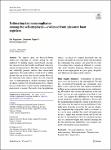Search
Author
- Marina, Dabić (3)
- Christa, Sys (2)
- Domingo, Ribeiro-Soriano (2)
- Gittell, Ross (2)
- next >
Subject
- kinh tế (26)
- Economics (12)
- Management science (7)
- Development Economics (6)
- next >
Date issued
- 2020 - 2023 (306)
- 2010 - 2019 (47)
- 2009 - 2009 (1)
Has File(s)
- true (354)
Search Results
The benefits and costs of wildlife are contingent on the spatial overlap of animal populations with economic and recreational human activities. By using a production function approach with dynamic spatial panel data models, we analyze the effects of human hunting and carnivore predation pressure on the value of ungulate game harvests. The results show evidence of dynamic spatial dependence in the harvests of roe deer and wild boar, but not in those of moose, which is likely explained by the presence of harvesting quotas for the latter. Results suggest the impact of lynx on roe deer harvesting values is reduced by 75% when spatial effects are taken into account. The spatial analysis confirms that policymakers’ aim to reduce wild boar populations through increased hunting has been suc... |
We compare the forecasting performance of small and large Bayesian vector-autoregressive (BVAR) models for the United States. We do the forecast evaluation of the competing models for the sample that ends before the pandemic and for the sample that contains the pandemic period. The findings document that these models can be used for structural analysis and generate credible impulse response functions. Furthermore, the results indicate that there are only small gains from the application of a large BVAR model compared to a small BVAR model. |
The early work by Kuznets and Chenery originally developed the theme that economic development was not simply a synonym for aggregate GDP growth, but entailed qualitative changes in the structures of production, employment, and consumption. Later work in international business and economics explored the co-evolution between FDI and economic structure. We investigate the co-evolution between FDI, economic structure and export structures in the two largest Latin American economies, Brazil and Mexico, over the period 2000–2015. Both initially followed similar development strategies during the import-substitution era. |
We improve upon the Pissarides-Weber method for estimating tax evasion among the self-employed by utilizing unique register-based consumption measures from the Swedish and Finnish mandatory registers for pleasure boats. This allows for more detailed and statistically powered analyses than survey-based applications. Our results indicate overall levels of hidden incomes that are in line with previous studies. However, the functional form analysis shows that the estimated sizes of underreporting in absolute monetary amounts are almost constant over reported income levels, whereas previous studies have assumed that the underreporting is proportional to income. The results from the preference analysis—in which we compare households that will become self-employed in the near future with h... |
Course timetables are the organizational foundation of a university’s educational program. While students and lecturers perceive timetable quality individually according to their preferences, there are also collective criteria derived normatively such as balanced workloads or idle time avoidance. A recent challenge and opportunity in curriculum-based timetabling consists of customizing timetables with respect to individual student preferences and with respect to integrating online courses as part of modern course programs or in reaction to flexibility requirements as posed in pandemic situations. Curricula consisting of (large) lectures and (small) tutorials further open the possibility for optimizing not only the lecture and tutorial plan for all students but also the assignments o... |
The causes of the 2007-8 subprime crisis continue to be the subject of much debate, with explanations ranging from de-regulation and fraudulent behavior to global imbalances and rising inequality. However, a comprehensive analysis of the endogenous forces that made the crisis inevitable has yet to be presented. This paper offers a ‘structural’ interpretation of the crisis by synthesising insights from conventional financial economics and the Minskyian and Schumpeterian literature. |
When the European Union expanded eastward in 2004 and 2007 to accession the so-called EU8 and EU2 countries, respectively, the incumbent member states imposed temporary restrictions on the employment of EU8 and EU2 nationals. Self-employed individuals were exempted from these transitional arrangements, prompting concerns that self-employment could be used as a means to evade the restrictions on labour market access. If the transitional arrangements led to an increase in EU8 and EU2 nationals’ self-employment rates, as previous research suggests, then their removal should have led to a corresponding decrease. This article analyses whether the latter has indeed been the case. |
A systemic perspective is considered helpful when facing complex organizational challenges, but its practical implementation may be challenging. A potential effective method that facilitates the practical application of a systemic perspective may be the Systemic Constellation method. This method aims to raise individuals’ awareness of their social context and to render explicit their tacit knowledge relating to this social context. In recent decades, consultants, coaches, and other professionals, worldwide, have adopted this method, acquired through self-education. However, thus far, this method received only little attention from the scientific community and scientific evidence on the effectiveness of the method is limited. There is currently almost no data on professionals using t... |
Many studies showed that marrying younger is associated with a higher risk of divorce. We investigate the causal effect of marrying at an earlier age on women’s divorce risk. We exploit the introduction of the 1981 reform in China, which facilitated legal marriage for urban women younger than 25 years old, using the Chinese Census data. We show that the reform generated a kink in the mean age at marriage for women, which we use in a fuzzy regression kink design (RKD) to assess the causal effect of marrying younger on the probability of divorce. First, we confirm in our data the existence of a negative (in fact, a U-shaped) association between age at marriage and divorce, as commonly observed in previous studies from the USA. |
Principles of Marketing is designed to meet the scope and sequence for a one-semester marketing course for undergraduate business majors and minors. Principles of Marketing provides a solid grounding in the core concepts and frameworks of marketing theory and analysis so that business students interested in a major or minor in marketing will also be prepared for more rigorous, upper-level elective courses. Concepts are further reinforced through detailed, diverse, and realistic company and organization scenarios and examples from various industries and geographical locations. To illuminate the meaningful applications and implications of marketing ideas, the book incorporates a modern approach providing connections between topics, solutions, and real-world problems. Principles of Mar... |










